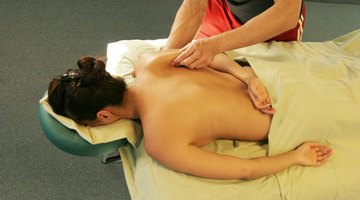How Do I Make a Home Chiropractic Table?
When planning to build a chiropractic table for home use, several features must be considered. First, the height must not only allow the person being treated to get on and off with ease but must allow the person helping with or administering the chiropractic care a comfortable reach.

Things You Will Need
- Tape measure
- Sturdy table
- Supportive foam and padding
- Vinyl or canvas cloth
- Staple gun
- Scissors
- Blade for cutting the foam
Additionally, the table must be comfortable for the person lying on it and must provide support for chiropractic adjustments, stretches and treatment.
-
Acquire a table either by finding a ready-made table or by building your own. If you don't wish to build your own, look for a table with a surface length and width that will support the person lying on it and a height that works for everyone involved. If building a table is preferred, contact a local chiropractic office for dimension advice or check measurements of chiropractic tables sold online.
-
Select a foam cushion that provides enough support to allow a person to rest on the table for up to 30 minutes, which should include repositioning on the table. The underlying table surface will be hard, so positioning on the side of the body, flat on the back, or face down may become painful if enough cushion is not provided. Cut or trim the foam to fit on the table's surface. The easiest way is to take tabletop measurements to the store where you buy your foam so the clerk can cut it to specifications.
-
Position the foam on the surface of the table. It is not necessary to glue the foam to the surface directly since the covering will hold it in place. If additional padding is desired, place above the foam piece before adding the covering.
-
Drape the vinyl or canvas over the foam and position in such a way that there is sufficient excess extending below the tabletop. There needs to be at least one inch of excess cloth past the bottom edge of the tabletop in order to secure the covering properly. Trim the covering if necessary.
-
Use the staple gun to secure the covering to the underside of the tabletop. For efficiency, secure at the four corners first, then switch between sides to help keep the covering even. It should be snug but not so tight that it depresses the foam.
Tip
If a piece of foam large enough for the table top cannot be found in the right size, two or three smaller pieces of the same foam, cut the same size and aligned to fit the surface, can be used. Gluing these pieces together is optional.
References
Tips
- If a piece of foam large enough for the table top cannot be found in the right size, two or three smaller pieces of the same foam, cut the same size and aligned to fit the surface, can be used. Gluing these pieces together is optional.
Writer Bio
Sasha Maggio specializes in topics related to psychology, fitness, nutrition, health, medicine, dentistry, and recovery after surgery, as well as cultural topics including Buddhism, Japanese culture, travel, languages and cooking. She holds a Bachelor of Arts in psychology and Japanese from the University of Hawaii, as well as a Master of Arts in forensic psychology. She is currently pursuing Medical and PhD programs.
Photo Credits
- massage therapy at the spa image by MAXFX from Fotolia.com
- massage therapy at the spa image by MAXFX from Fotolia.com
More Articles



